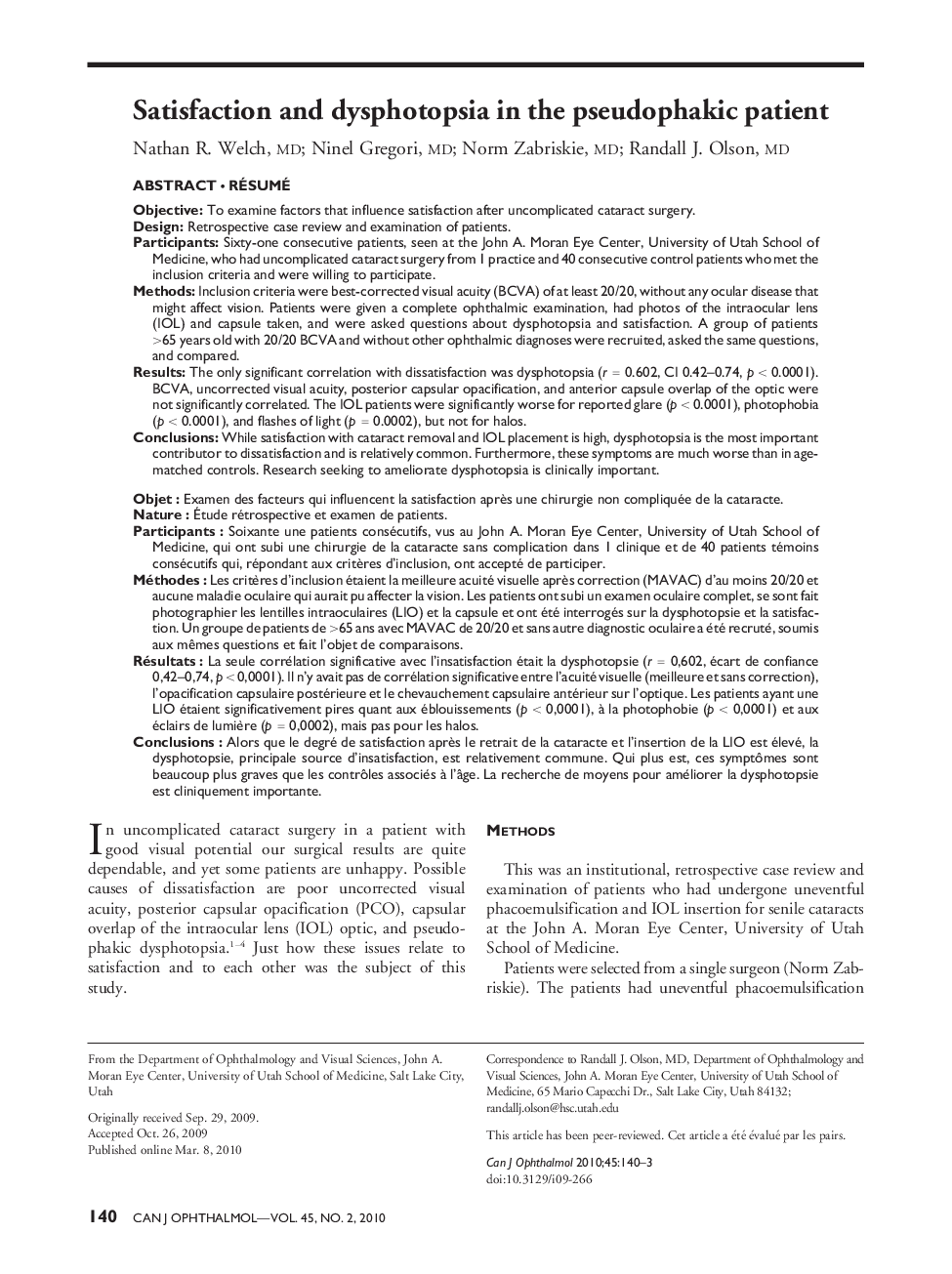| Article ID | Journal | Published Year | Pages | File Type |
|---|---|---|---|---|
| 4010358 | Canadian Journal of Ophthalmology / Journal Canadien d'Ophtalmologie | 2010 | 4 Pages |
Objective: To examine factors that influence satisfaction after uncomplicated cataract surgery.Design: Retrospective case review and examination of patients.Participants: Sixty-one consecutive patients, seen at the John A. Moran Eye Center, University of Utah School of Medicine, who had uncomplicated cataract surgery from 1 practice and 40 consecutive control patients who met the inclusion criteria and were willing to participate.Methods: Inclusion criteria were best-corrected visual acuity (BCVA) of at least 20/20, without any ocular disease that might affect vision. Patients were given a complete ophthalmic examination, had photos of the intraocular lens (IOL) and capsule taken, and were asked questions about dysphotopsia and satisfaction. A group of patients >65 years old with 20/20 BCVA and without other ophthalmic diagnoses were recruited, asked the same questions, and compared.Results: The only significant correlation with dissatisfaction was dysphotopsia (r = 0.602, CI 0.42–0.74, p < 0.0001). BCVA, uncorrected visual acuity, posterior capsular opacification, and anterior capsule overlap of the optic were not significantly correlated. The IOL patients were significantly worse for reported glare (p < 0.0001), photophobia (p < 0.0001), and flashes of light (p = 0.0002), but not for halos.Conclusions: While satisfaction with cataract removal and IOL placement is high, dysphotopsia is the most important contributor to dissatisfaction and is relatively common. Furthermore, these symptoms are much worse than in age-matched controls. Research seeking to ameliorate dysphotopsia is clinically important.
RésuméObjet: Examen des facteurs qui influencent la satisfaction après une chirurgie non compliquée de la cataracte.Nature: Étude rétrospective et examen de patients.Participants: Soixante une patients consécutifs, vus au John A. Moran Eye Center, University of Utah School of Medicine, qui ont subi une chirurgie de la cataracte sans complication dans 1 clinique et de 40 patients témoins consécutifs qui, répondant aux critères d’inclusion, ont accepté de participer.Méthodes: Les critères d’inclusion étaient la meilleure acuité visuelle après correction (MAVAC) d’au moins 20/20 et aucune maladie oculaire qui aurait pu affecter la vision. Les patients ont subi un examen oculaire complet, se sont fait photographier les lentilles intraoculaires (LIO) et la capsule et ont été interrogés sur la dysphotopsie et la satisfaction. Un groupe de patients de >65 ans avec MAVAC de 20/20 et sans autre diagnostic oculaire a été recruté, soumis aux mêmes questions et fait l’objet de comparaisons.Résultats: La seule corrélation significative avec l’insatisfaction était la dysphotopsie (r = 0,602, écart de confiance 0,42–0,74, p < 0,0001). Il n’y avait pas de corrélation significative entre l’acuité visuelle (meilleure et sans correction), l’opacification capsulaire postérieure et le chevauchement capsulaire antérieur sur l’optique. Les patients ayant une LIO étaient significativement pires quant aux éblouissements (p < 0,0001), à la photophobie (p < 0,0001) et aux éclairs de lumière (p = 0,0002), mais pas pour les halos.Conclusions: Alors que le degré de satisfaction après le retrait de la cataracte et l’insertion de la LIO est élevé, la dysphotopsie, principale source d’insatisfaction, est relativement commune. Qui plus est, ces symptômes sont beaucoup plus graves que les contrôles associés à l’âge. La recherche de moyens pour améliorer la dysphotopsie est cliniquement importante.
